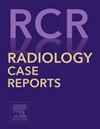Partial duplication of the anterior communicating artery: A case report
Q4 Medicine
引用次数: 0
Abstract
Anatomical variations in the anterior cerebral artery and/or anterior communicating artery complex are common. However, partial duplication is a rare variant of the anterior communicating artery. To the best of our knowledge, there are only a few reports describing a partially duplicated anterior communicating artery. We report a case of a partially duplicated anterior communicating artery associated with an intracranial aneurysm, which was diagnosed by 3-Tesla magnetic resonance angiography and digital subtraction angiography. A 43-year-old woman was admitted to our hospital for postoperative examinations following coil embolization of an unruptured right internal carotid artery aneurysm performed 1 year earlier. Magnetic resonance angiography and digital subtraction angiography revealed no recurrence of the treated aneurysm, and a partially duplicated anterior communicating artery—there were 2 separate anterior communicating arteries on the right side and one on the left side. Digital subtraction angiography under contralateral carotid artery compression showed no aneurysm in the anterior communicating artery complex. This report provides additional evidence of partially duplicated anterior communicating arteries associated with an intracranial aneurysm. Careful imaging assessment is important to identify this rare anatomical variant, as well as other concomitant variations and associated aneurysms.
前交通动脉部分重复1例
大脑前动脉和/或前交通动脉复合体的解剖变异是常见的。然而,前交通动脉的部分重复是一种罕见的变异。据我们所知,只有少数报告描述了部分复制的前交通动脉。我们报告一个部分复制的前交通动脉合并颅内动脉瘤的病例,这是由3-特斯拉磁共振血管造影和数字减影血管造影诊断。一名43岁的女性在1年前对未破裂的右侧颈内动脉瘤进行线圈栓塞手术后入院接受术后检查。磁共振血管造影和数字减影血管造影显示治疗后动脉瘤未复发,前交通动脉部分复制,右侧有2条独立的前交通动脉,左侧有1条。对侧颈动脉压迫下的数字减影血管造影显示前交通动脉复合体未见动脉瘤。本报告提供了部分重复的前交通动脉与颅内动脉瘤相关的额外证据。仔细的影像学评估对于识别这种罕见的解剖变异以及其他伴随变异和相关动脉瘤非常重要。
本文章由计算机程序翻译,如有差异,请以英文原文为准。
求助全文
约1分钟内获得全文
求助全文
来源期刊

Radiology Case Reports
Medicine-Radiology, Nuclear Medicine and Imaging
CiteScore
1.10
自引率
0.00%
发文量
1074
审稿时长
30 days
期刊介绍:
The content of this journal is exclusively case reports that feature diagnostic imaging. Categories in which case reports can be placed include the musculoskeletal system, spine, central nervous system, head and neck, cardiovascular, chest, gastrointestinal, genitourinary, multisystem, pediatric, emergency, women''s imaging, oncologic, normal variants, medical devices, foreign bodies, interventional radiology, nuclear medicine, molecular imaging, ultrasonography, imaging artifacts, forensic, anthropological, and medical-legal. Articles must be well-documented and include a review of the appropriate literature.
 求助内容:
求助内容: 应助结果提醒方式:
应助结果提醒方式:


